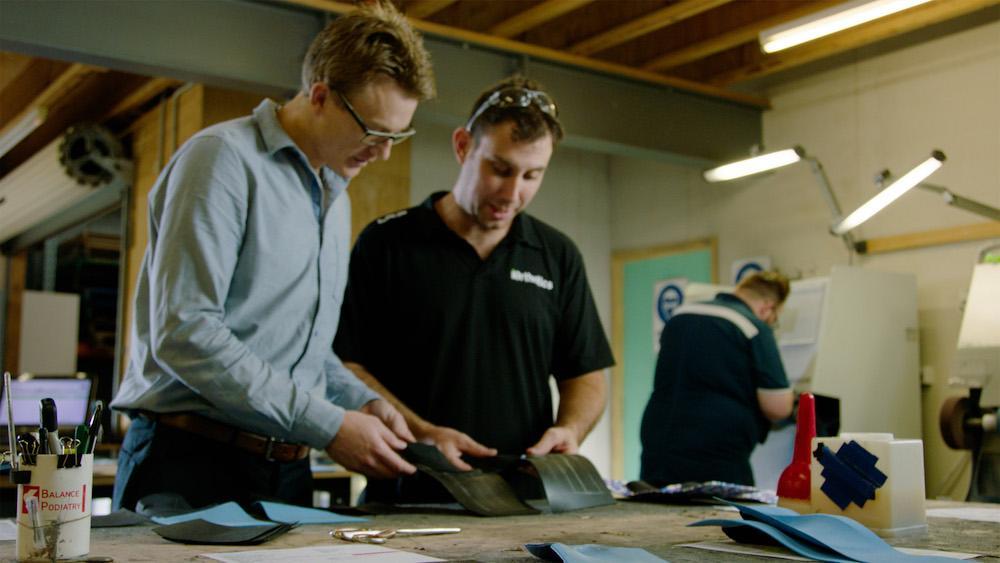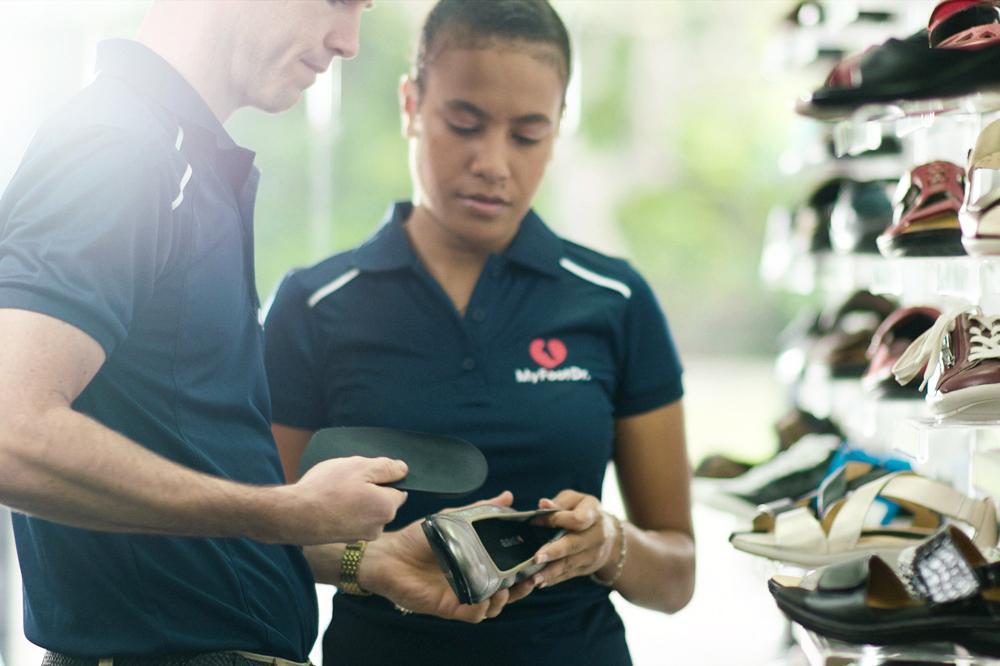For Patients, For the Planet — With 3D Printing, One Orthotics Company is Really Stepping Up
Christopher enters a shady patio outside the doctor’s office. The 8-year-old is sporting his school uniform – red top, blue shorts – and a face full of focus. Time for a test walk.
Nearby, his mom and a doctor watch him slowly move forward. They like what they see. His right foot and ankle are wrapped in a new, lightweight brace made just for him four days earlier on an HP 3D printer. They peer particularly hard at Christopher’s right side – weakened by a stroke months before his birth.
His steps turn into a confident stroll. “That’s good!” his mom says.
“Look, his gait is really symmetrical,” the doctor says. “A bit quicker, mate!”
Christopher’s stroll becomes a jog in the Brisbane, Australia, heat. Then his jog becomes a sprint. Finally, his focus becomes a full-on grin.
“This is why we do what we do,” says Dean Hartley, a podiatrist and co-founder of iOrthotics, the Australian company that made Christopher’s brace and thousands more. “You see that smile on his face. Then you see the smile from the parents. It’s amazing.”
Hartley is spearheading an orthotics revolution, relying on HP Jet Fusion 4200 3D printers to manufacture tens of thousands of pairs of custom foot orthotics and foot-and-ankle braces each year to help patients in the U.S., Australia, U.K., Canada, China and Singapore gain the ability to walk or improve their mobility.
In fact, iOrthotics is one of the first orthotics companies in the world to transition its lab to 3D printing, replacing a traditional technique that produces pressed and milled polypropylene devices – a method that sends thousands of tons of scrap plastic to landfills. By comparison, the use of 3D printing for orthotics creates small amounts of waste, Hartley says.
“This technology – and what we're doing with it – has the ability to change the whole orthotics industry,” Hartley says.
“Walking or running, it’s something so simple, something so many of us take for granted. Then you see a patient who hasn't been able to do it properly, and you can actually change that for them. You see them experience something for the first time. It’s why we practice,” he adds.
3D-printed orthotics can be suitable for the treatment of foot pain and provide pain relief and walking support for people diagnosed with diabetes, arthritis, flat feet and other medical conditions, according to the iOrthotics website.
Launched in 2009 in Queensland, iOrthotics is a subsidiary of Healthia, which operates a network of more than 130 My FootDr Podiatry clinics, Allsports Physiotherapy and Extend Hand Therapy clinics across Australia. (Hartley also serves as the chief information officer for Healthia.)
By using HP Jet Fusion 3D printers, iOrthotics builds its braces bit-by-bit – adding individual layers of material each as thin as 100 microns, the thickness of a sheet of paper. This creates a customized fit matching the unique bone, tendon and muscle contours of a patient’s foot, Hartley says. The result is a lighter, more durable device.
3D printing also streamlines the time patients must wait for new orthotics, carving weeks or months off the old process and getting people back on their feet sooner.
Traditionally, a doctor or therapist examines a patient then refers that patient to a hospital orthotics clinic or to an orthotist working in a medical setting. The orthotist makes a plaster cast of the foot and ankle needing correction.
Based on that plaster mold, the orthotist builds a plaster model and vacuum forms heated plastic over the modified cast. From start to finish, that can take several weeks or as long as three or four months.
Traditional foot orthotic laboratories typically take 3D-scanned foot profiles and mill out the foot orthotics from a solid block of plastic material – a process known as subtractive manufacturing.
iOrthotics, on the other hand, ensures that all orders are made and sent to patients in three to five business days. Podiatrists in the Healthia network use 3D foot scanning to measure the foot profiles, sending that data directly to iOrthotics to print the devices and outfit the patients.
“With the HP printers, we can bypass that whole middle step,” Hartley says.
And speed is certainly crucial – both in brace fabrication and on foot.
On the day that Christopher recently tested his first, 3D-printed brace, he was thrilled at the quick pace he achieved while tearing across that patio, recalls his mother, Amanda Wuth.
“He was excited. He was going pretty fast. It was like getting a new bike, just whiz-bam amazing. That’s how he felt,” Wuth says. “It didn’t rub. It was lightweight. It was relief and joy at the same time.”
Since he was 15 months old, Christopher has worn a series of right foot and ankle braces – the result of right-side muscle weakness throughout his body caused by the in-utero stroke.
The devices allowed him to develop into a rough-and-tumble boy who often disregards his disability to keep up with friends, his mom says. He has run cross-country races in school competitions (finishing long after classmates yet without complaint). He plays soccer at lunch and touch rugby in the evening.
“He always gives it a go. He likes to be amongst the action,” Wuth says. She and her family live in Thornlands, a coastal suburb about 20 miles southeast of Brisbane.
But as Christopher outgrew each pair of traditional orthotics, the wait for every new set was long, often a month or more.
“It was never ready for him. I was getting really frustrated,” Wuth said. “In that period, he wouldn’t be walking correctly, which has implications on bone growth, gait, and the use of muscles we don’t want him to use while walking. The waits took up so much of his life. A month is a really long time for a child.”
3D-printed orthotics let Christopher switch between different sports seamlessly and move in the best way possible. He will of course outgrow it, Wuth knows, but she doesn’t worry because he will be able to have a new one instantly. “This is going to change everything,” she says. “This is going to have a big impact on kids like Christopher.”
The new process enables manufacturers to reduce the overall thickness of an orthotic down to 2 millimeters or less, creating better flexibility and comfort, says Greg Dower, co-founder and chief business development officer of My FootDr. He is also a podiatrist.
That, in turn, also enables patients like Christopher to wear standard footwear instead of medical grade shoes typically needed to fit over bulky braces. It also saves patients the time often needed to struggle into and out of larger orthotics.
“Patients can get on with their lives with less fuss and more confidence in themselves,” says Dower – the doctor who was present when Christopher took those first steps in his new 3D-printed device.
“It was a beautiful moment,” Dower says. “He showed us all how important it is to get it right — the first time — for kids.”
But Dower is equally drawn, he says, to the green aspects that 3D printing injects into the industry. By using the new technology, he estimates he has saved as many as 50 garbage-truck loads of micro plastics from ending up in landfills. That’s the typical byproduct of conventional orthotics making – machines routing them out of large blocks of polypropylene or plastic.
“It’s terrible for the environment,” Dower says. “We have to leave this beautiful planet in the best shape possible we can for our kids.”
Hartley agrees. “One of our main motivations for moving to 3D printing was around waste,” he says. “We wanted to reduce our carbon footprint and plastic waste.”
The numbers are stark. Traditional orthotics manufacturing generates about 5 pounds of polypropylene waste per pair. That means a company producing 10,000 pairs annually using the old method would create about 26 tons of plastic trash, Hartley says.
Those plastic scraps would sit in landfills for up to 1,000 years, according to some estimates.
“Which is just ludicrous,” Hartley says. “Why do a method that is so wasteful when it could be done better?”
An orthotics company using 3D printing to make the same number of pairs over a year would yield less than one ton of waste, Hartley says.
Even better, iOrthotics primarily prints its braces with a material called PA11, produced from castor beans, a bio-renewable source.
“It’s far, far, far better than using polypropylene,” Hartley says.
“As a business, we don't want to just keep doing the same thing that everyone else does. We want to continue to innovate – around sustainability and for the patients.
HP Inc. creates technology that makes life better for everyone, everywhere. Through our portfolio of personal systems, printers, and 3D printing solutions, we engineer experiences that amaze. More information about HP Inc. is available at www.hp.com/go/3DPrint.





